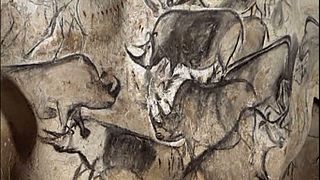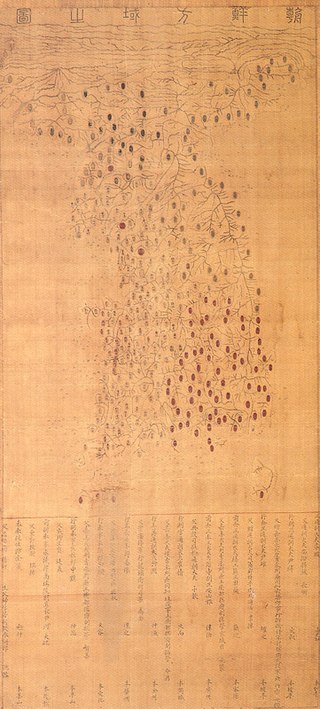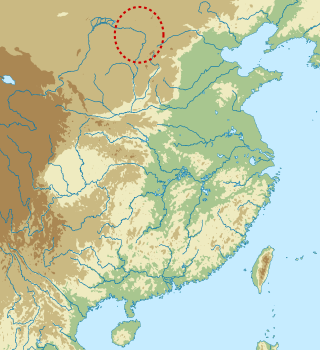The Iron Age is the final epoch of the three historical Metal Ages, after the Copper and Bronze Ages. It has also been considered as the final Age of the three-age division starting with prehistory and progressing to protohistory. In this usage, it is preceded by the Stone Age and Bronze Age. These concepts originated in describing Iron Age Europe and the Ancient Near East, but they now include other parts of the Old World.

The Yayoi period started in the late Neolithic period in Japan, continued through the Bronze Age, and towards its end crossed into the Iron Age.

The Geumg River is located in South Korea. It is a major river that originates in Jangsu-eup, North Jeolla Province. It flows northward through North Jeolla and North Chungcheong Provinces and then changes direction in the vicinity of Greater Daejeon and flows southwest through South Chungcheong Province before emptying into the Yellow Sea near Gunsan city.

In the history of art, prehistoric art is all art produced in preliterate, prehistorical cultures beginning somewhere in very late geological history, and generally continuing until that culture either develops writing or other methods of record-keeping, or makes significant contact with another culture that has, and that makes some record of major historical events. At this point ancient art begins, for the older literate cultures. The end-date for what is covered by the term thus varies greatly between different parts of the world.

Gojoseon, also called Joseon, was the first kingdom on the Korean Peninsula. According to Korean mythology, the kingdom was established by the legendary king Dangun. Gojoseon possessed the most advanced culture in the Korean Peninsula at the time and was an important marker in the progression towards the more centralized states of later periods. The addition of Go, meaning "ancient", is used in historiography to distinguish the kingdom from the Joseon dynasty, founded in 1392 CE.

Buyeo or Puyŏ, also rendered as Fuyu, was an ancient kingdom that was centered in northern Manchuria in modern-day northeast China. It is considered a Korean kingdom, and had ties to the Yemaek people, who are considered to be the ancestors of modern Koreans. Buyeo is a major predecessor of the Korean kingdoms of Goguryeo and Baekje.

Gobeunok or Gogok are comma-shaped or curved beads and jewels that appeared from middle age of Mumun Period through the Three Kingdoms of Korea. The Gogok is posited by researchers to have been a symbol of prestige among Mumun culture community leaders as the tombs of presumably powerful figures were oftentimes accompanied by bronze daggers, stone daggers, and comma-shaped jewels. The Gogok's role as a symbol of prestige would carry onto the Three Kingdoms Period of Korea (as Gogok would remain a salient feature of Korean royal paraphernalia. They range in size range from 1 to 10 centimetres, and are oftentimes fashioned with a hole to be attached or threaded to another object. The origin of these comma-shaped jewels are posited by some to originate from the dragon-shaped jadeite ornament of the Hongshan culture of the Liao River Basin. However, due to the spatial and temporal distance, most researchers have been skeptical of their genealogical relationship. The generally accepted interpretation in academia is that the form of the comma-shaped jewel originated from the canine teeth of predator animals or as a symbol of a half-moon sacred to moon worshippers, or as a symbol of fetus and or fertility.

The Peninsular Japonic languages are now-extinct Japonic languages reflected in ancient placenames and glosses from central and southern parts of the Korean Peninsula.

The state of Jin was a confederacy of statelets which occupied some portion of the southern Korean peninsula from the 4th to 2nd centuries BCE, bordering the Korean Kingdom of Gojoseon to the north. Its capital was somewhere south of the Han River. It preceded the Samhan confederacies, each of which claimed to be the successor of the Jin state.

The Proto–Three Kingdoms period refers to the proto-historical period in the Korean Peninsula, after the fall of Gojoseon and before the maturation of Goguryeo, Baekje, and Silla into full-fledged kingdoms. It is a subdivision of what is traditionally called Korea's Three Kingdoms Period and covers the first three centuries of the Common Era, corresponding to the later phase of the Korean Iron Age.

The Mumun pottery period is an archaeological era in Korean prehistory that dates to approximately 1500-300 BC. This period is named after the Korean name for undecorated or plain cooking and storage vessels that form a large part of the pottery assemblage over the entire length of the period, but especially 850-550 BC.

The Gochang, Hwasun and Ganghwa Dolmen Sites are the location of hundreds of stone dolmens which were used as grave markers, and for ritual purposes during the first millennium BCE when the Megalithic Culture was prominent on the Korean Peninsula. The sites were designated as a World Heritage Site by UNESCO in 2000. The Korean Peninsula is home to over 35,000 dolmens, accounting for approximately 40% of the world's total; the Gochang, Hwasun, and Ganghwa sites are themselves home to over 1,000 dolmens.

The Zhukaigou culture was a late Neolithic and early Bronze Age culture centered in the Ordos Plateau of Inner Mongolia, China. The type site at Zhukaigou was discovered in Ejin Horo Banner, Inner Mongolia, and excavated from 1977 to 1984. Zhukaigou culture is a reputed progenitor of the Ordos bronze culture and accordingly a first "Northern Zone" culture, extending to northern and central Inner Mongolia, northern Shaanxi, and northern Shanxi, with the Ordos region at its center. Transition to metalworking is dated to around the end of the third millennium BCE, at the same time was attained a higher level in the ceramic. Zhukaigou culture lasted to c. 1500 BCE.

The ancient Cycladic culture flourished in the islands of the Aegean Sea from c. 3300 to 1100 BCE. Along with the Minoan civilization and Mycenaean Greece, the Cycladic people are counted among the three major Aegean cultures. Cycladic art therefore comprises one of the three main branches of Aegean art.
The Upper Xiajiadian culture was a Bronze Age archaeological culture in Northeast China derived from the Eurasian steppe bronze tradition.

Igeum-dong is a complex archaeological site located in Igeum-dong, Samcheonpo in Sacheon-si, South Gyeongsang Province, South Korea. This prehistoric archaeological site is important in Korean prehistory because it represents solid evidence that simple chiefdoms formed in as early as the Middle Mumun, some 950 years before the first state-level societies formed in Korea. The settlement is dated by pottery, pit-house types, and an AMS radiocarbon date to the Late Middle Mumun Pottery Period. Test excavations were conducted in 1997, and wide-scope horizontal excavations took place in 1998 and 1999.

Songguk-ri is a Middle and Late Mumun-period archaeological site in Buyeo-gun, Chungcheongnam-do, South Korea. Songguk-ri is a settlement and burial site that is important in the study of Korean prehistory. It is registered as Historical Site No. 249. Songguk-ri is a main point of reference in Korean prehistory—Korean archaeologists have represented the prehistoric village and the material culture excavated from there as the type-site for Middle Mumun Culture in southern Korea.

Prehistoric Korea is the era of human existence in the Korean Peninsula for which written records do not exist. It nonetheless constitutes the greatest segment of the Korean past and is the major object of study in the disciplines of archaeology, geology, and palaeontology.

The Steppe Route was an ancient overland route through the Eurasian Steppe that was an active precursor of the Silk Road. Silk and horses were traded as key commodities; secondary trade included furs, weapons, musical instruments, precious stones and jewels. This route extended for approximately 10,000 km (6,200 mi). Trans-Eurasian trade through the Steppe Route preceded the conventional date for the origins of the Silk Road by at least two millennia.
Xituanshan is a Late Bronze Age group of stone burials in Jilin, China. It was designated a Major National Historical and Cultural Site by the Chinese government in 2001.















